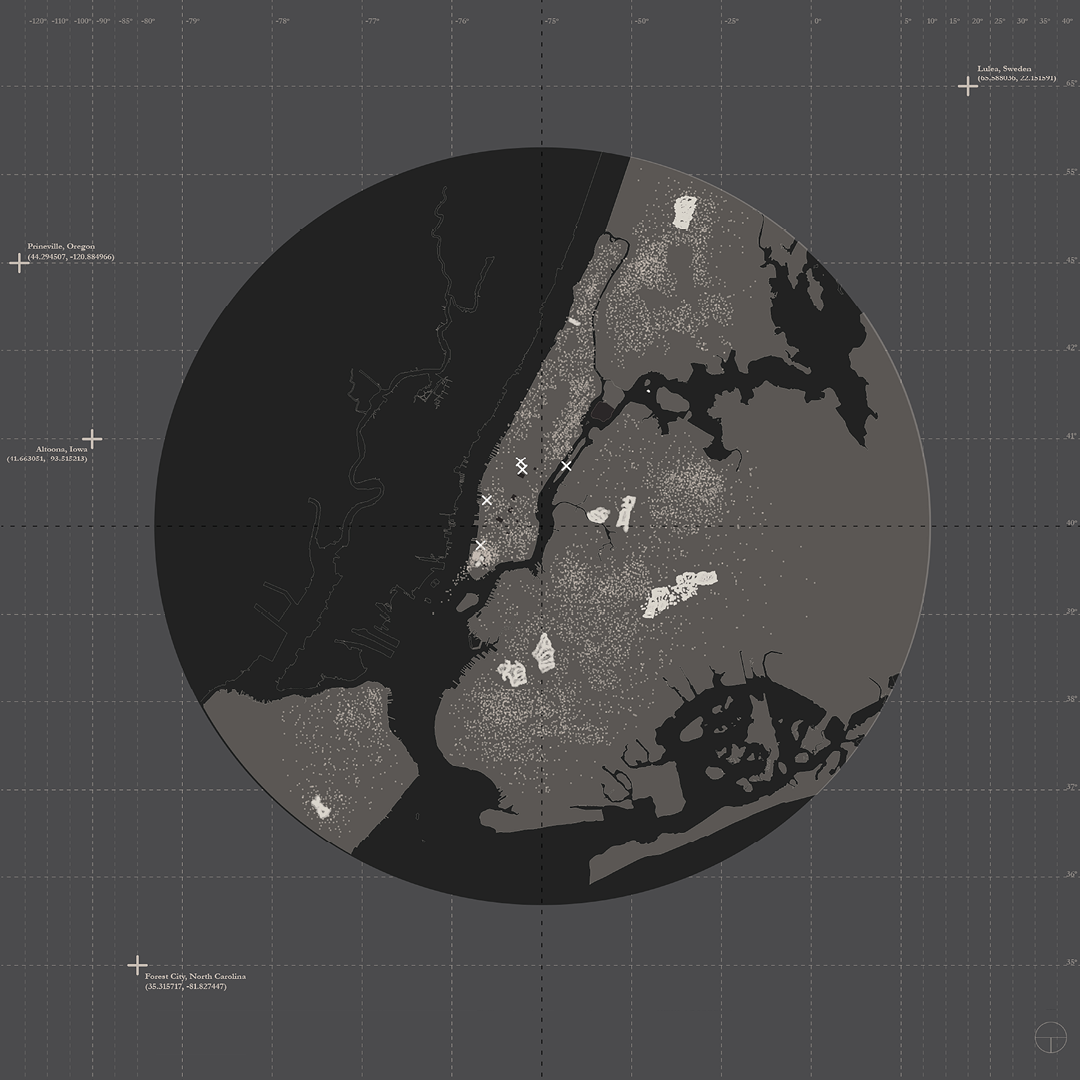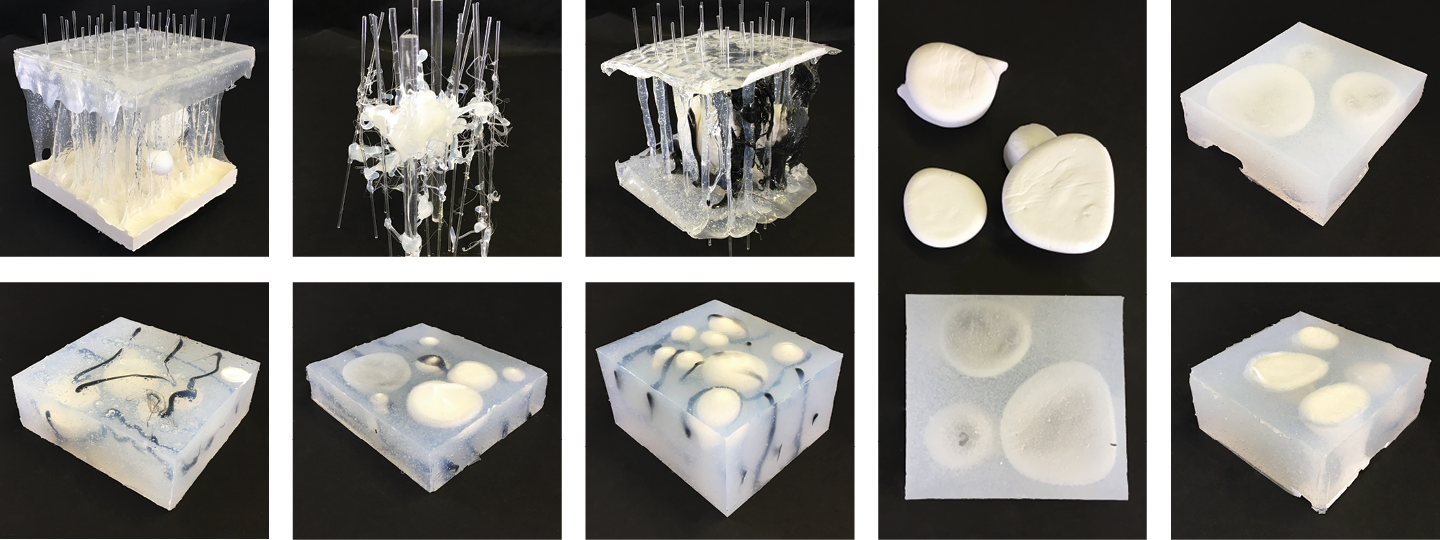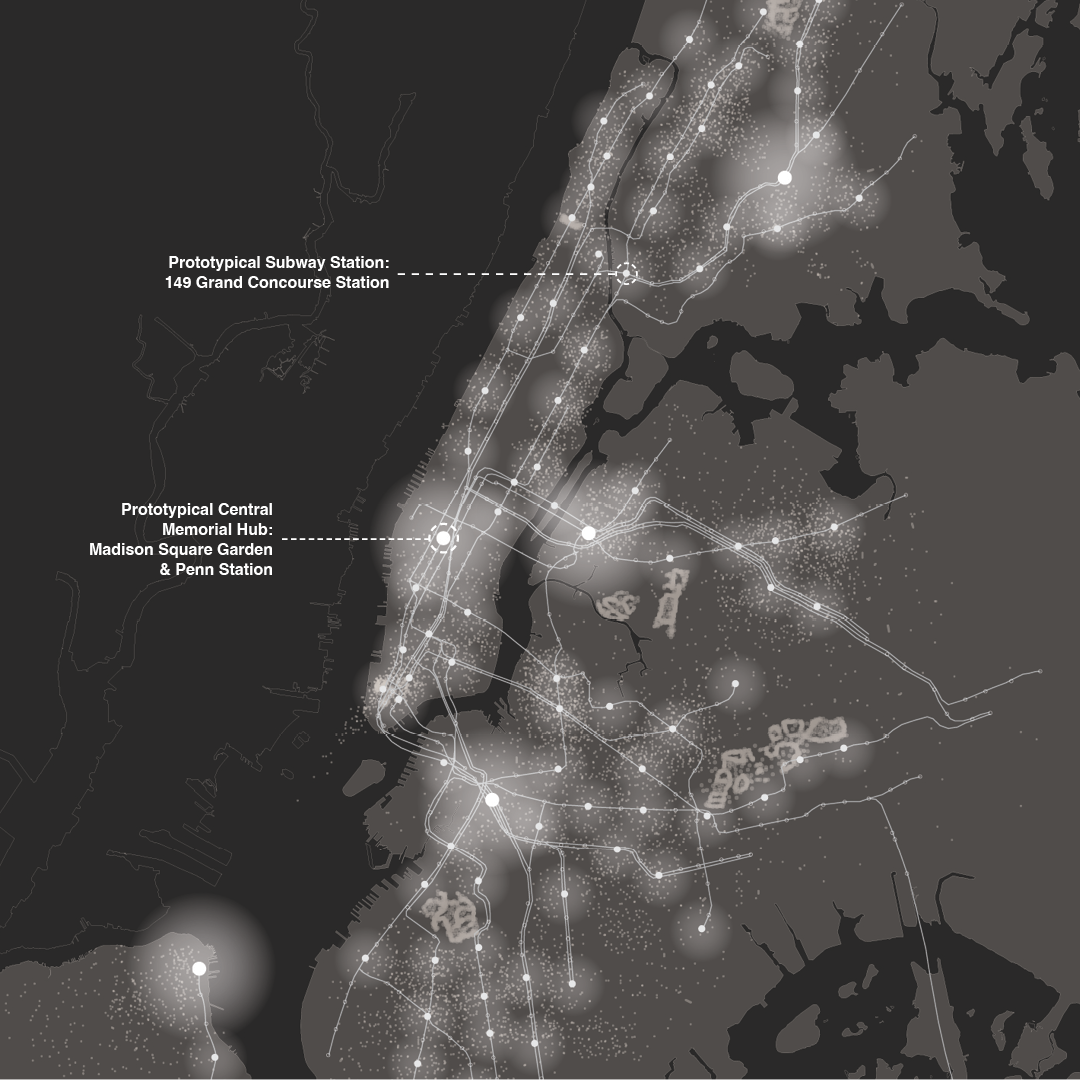#RIP: Encoding Memory
GSAPP Advanced Studio
Instructor: Karla Rothstein
Partners: Eric Giragosian, Min He
Summer 2017

We believe memory is identity.
How we are remembered defines who we are.
It is a choice to encode our identities, either physically as engravings on a headstone or digitally utilizing social media. Researching various procedures of displacement of the deceased and the living, we mine existing system deficiencies and disruptions within Manhattan.
The current state reveals remembrance and memorialization uprooted from the island, disconnecting the sites where memories were originally created and celebrated. This project bridges the disintegration between where memories were made and where they exist after death.
By grafting onto the subway’s existing nodal network, we will celebrate traces and reverberations, returning memorialization to Manhattan.
The project creates a network of memorial hubs; each of the five boroughs has a central memorial hub where promession takes place. The remains are then interred along the memorialization network where the smaller nodes are distributed across New York City subway stations.
 Death & Displacement in New York City - Map
Death & Displacement in New York City - Map Death & Displacement in New York City - Datascape
Death & Displacement in New York City - DatascapeThe history of New York City cemeteries is twined with displacement as rapid migarations to the city caused the spread of epidemics that led burial grounds within the city limits to fill until they ran out of space. From the early 1800s, Manhattan began pushing it’s interred population to rural surroundings, particularly those buried in Potter Fields; the place of burial for the of unknown, unclaimed or indigent people and victims of epidemics. First with burying them in Randal and Ward’s Islands, then to Brooklyn and Queens, until finally today at Hart Island.
 The New York City Subway Datascape
The New York City Subway Datascape
Aggregation of Instagram Posts using #RIP in New York City
The New York City Subway System is the busiest rapid transit rail system in the Western world by annual ridership. In 2015, the subway delivered over 1.76 billion rides. By studying incidents such as suicides, accidents and homicide taking place in the subway, a ripple effect of these incidents that influences the entire Subway system became evident. Using a datascape to track this aftermath, we are able to extract a series of phenomenons whenever there is a death-related incident on the subway.

Drawing from the Subway Death Datascape and the phenomenons of Path, Impact and Diversion, we embarked on a material investigation to unfold the repercussions of these subway incidents. The sets of experiments was built on establishing a system that is “impacted” by a foreign object.
These experiments led to us studying further the impact investigation minus the intended path already in the system. The final experiment shed light and intensified the relationship between solid and void.
Digital Afterlife and Mourning
In the age of social media, mourning takes on a new form as social platforms such as Facebook and Instagram offer the memorialization option for accounts of people who passed, with the word “Remembering” shown next to the deceased person’s name. This shift in the technology of remembrance certainly affects cemeteries, since gravestones allowed only so much memory of a person to be preserved for future generations.
In the last few years, some cemeteries around the world started offering the option of adding a QR Code to a grave that allows people to access information about the deceased person. While it is yet to become mainstream, it’s evident that as technology advances, the distance between digital and physical remembrance grows smaller and smaller.
What if they occupied the same space?

The Memorialization Network is a new infrastructure for death in New York City that will allow grieving families to bury their loved ones as close as possible to home by utilizing negative space within the Subway System.
This coupling of the Memorialization Network with the Subway System is a symbol for the close tie between life and death, and allows for remembrance and memorial to become a part of New Yorkers everyday rituals, slowing the fast pace to give room for contemplation.
This coupling of the Memorialization Network with the Subway System is a symbol for the close tie between life and death, and allows for remembrance and memorial to become a part of New Yorkers everyday rituals, slowing the fast pace to give room for contemplation.
Prototypical Central Memorial Hub: Madison Square Suspended Gardens Plan
The historical significance of Penn station lies in the displaced history of the station that came with the creation of Madison Square Garden. The project re-purposes MSG to act as the central memorial hub in Manhattan where the Promession process takes place.
A superimposed grid of data server towers is inserted into MSG and is used as structural support for the suspended gardens where the human remains are interred after promession.
This particular site offers the opportunity to bring back memorialization to Manhattan, since there’s only a handful of active cemeteries within the borough, and the chances of the average person being interred there are almost nonexistent.
By tapping into an important and busy point at the subway network, the project centers memorialization and allows for the distribution along the network.
 MSG Plan - Central Memorial Hub
MSG Plan - Central Memorial Hub
Congregation and Seating near Exterior Gardens
Accessing the information within the Data Servers allows for an immersive experience into the history of the city and its inhabitants. The Heat and Cold generated inside the Data Server Towers is used to regulate the temperatures in the Climate Controlled Gardens.


The Subway memorial nodes are distributed along the five boroughs in order to slow down the fast pace of the subway to allow for remembrance. The walls of the subway are re-purposed to become containers of the promains received from the Central Memorial Hub after the funeral.

Prototypical Subway Station:
149 Grand Concourse Station

Accumulation/Replacement of Promains Over Time
The promains are used to fertilize the soil of the gardens above the subway stations. Skylights enable light to enter below ground and allow observing the gardens from the platforms.



New York City Native Plants

